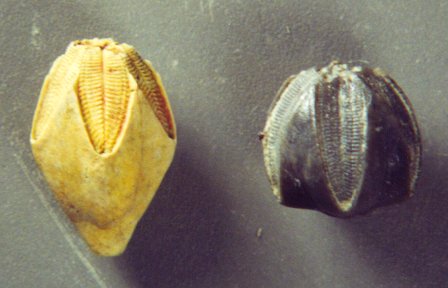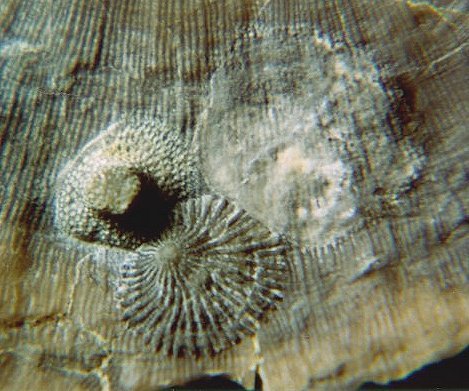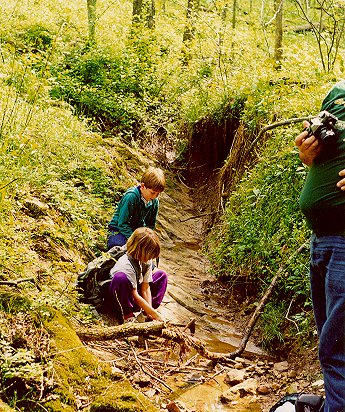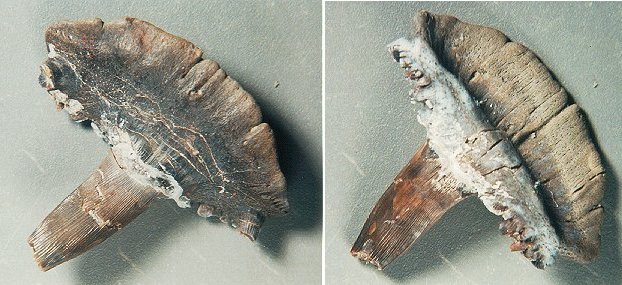

Pentremites blastoids
Near the town of Wax, beautifully preserved blastoids (Pentremites) can be found at a roadcut in the Mississippian Glen Dean Formation. They are a black color.
One blastoid collected in Wax, KY from the Glen Dean Formation may show traces of the original animal coloration or pigmentation pattern from when it was alive. The specimen shows a darkened deltoid area and some possible chevron patterns on the radials. A study in the March 1998 Journal of Paleontology by Beaver and Fabian (pages 332-338) illustrated original color patterns in Mississippian blastoids. Some of the specimens illustrated in the study were from the Glen Dean formation near Leitchfield, KY (which is just north of Wax).

Philhedra and Petrocrania inarticulate brachiopods and a bryozoan fighting for space on a Rafinesquina
A KPS trip to Indiana included a stop at the multi-bench roadcut on Rt. 1. This huge cut exposes Upper Ordovician rocks. Fossils to be found include many articulate brachiopods (Rafinesquina and others), some inarticulate brachiopods (Philhedra, Petrocrania) and enrolled Flexicalymene trilobites.

Dipping strata at Jeptha Knob
The KPS field trip to the Jeptha Knob Astrobleme featured a visit (with permission) to the top of Jeptha Knob in Shelby County, Kentucky. Members walked a creek bed descending from the top of the knob to look for evidence of the meteor impact event (which occured about 440 million years ago). Steeply dipping beds (some closer to vertical than horizontal) were discovered. These rock layers were part of the concentric fault system in the impact area. In addition, impact breccia (pronounced bre-cha) was also found. Breccia is a rock composed of angular fragments of other rocks.
The KPS took a field trip to visit some badland topography in Kentucky. The trip was led by Charlie Mason of Morehead St. University. In Bath Co. Kentucky, an area of exposed Silurian age Crab Orchard Shale has evolved into a badland setting with no vegetation covering the hills and gullies. This locality is several acres in size and is situated on private property. Of course, we had permission to visit. The Crab Orchard Shale was deposited in a "dysaerobic" environment, with reduced amounts of oxygen in the water. There are no full sized "adult" fossils to be found. However, a diverse community of miniature "juvenile" fossils (including gastropods, crinoid stems, trilobites, and brachiopods) can be located with diligent searching. Why are tiny fossils present, but no full sized versions? It is Charlie Mason's contention that the low oxygen content of the water was sufficient to harbor juvenile communities, but exclude adult ones. He suggests that this could have been an area where young animals devoloped in relative safety.

Front and back of large cladodontid shark tooth
This field trip consisted of going to a series of Mississippian (Borden Formation) roadcuts in West-Central Kentucky. On these cuts were discovered undescribed edrioasteroids (see section "fossil named after KPS"). They have been described by paleontologist Colin Sumrall. Also, a few nice small and one large cladodont shark tooth have been found. On the close-up image, notice all the tiny teeth flanking the large one!